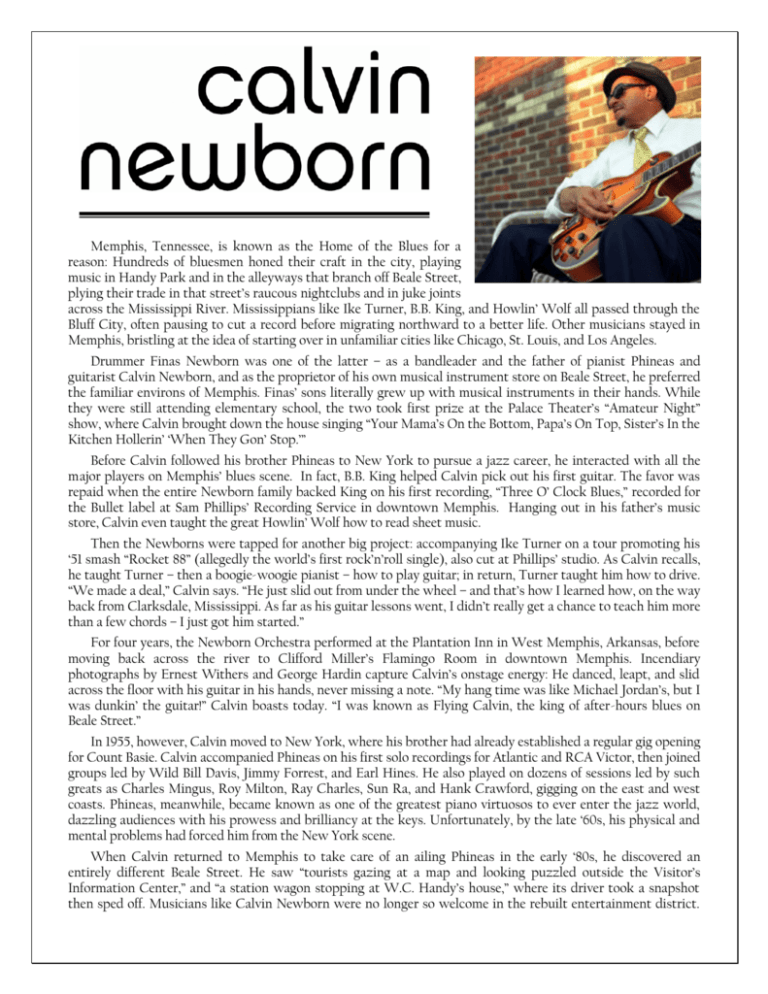Memphis, Tennessee, is known as the Home of the Blues for a
advertisement

Memphis, Tennessee, is known as the Home of the Blues for a reason: Hundreds of bluesmen honed their craft in the city, playing music in Handy Park and in the alleyways that branch off Beale Street, plying their trade in that street’s raucous nightclubs and in juke joints across the Mississippi River. Mississippians like Ike Turner, B.B. King, and Howlin’ Wolf all passed through the Bluff City, often pausing to cut a record before migrating northward to a better life. Other musicians stayed in Memphis, bristling at the idea of starting over in unfamiliar cities like Chicago, St. Louis, and Los Angeles. Drummer Finas Newborn was one of the latter – as a bandleader and the father of pianist Phineas and guitarist Calvin Newborn, and as the proprietor of his own musical instrument store on Beale Street, he preferred the familiar environs of Memphis. Finas’ sons literally grew up with musical instruments in their hands. While they were still attending elementary school, the two took first prize at the Palace Theater’s “Amateur Night” show, where Calvin brought down the house singing “Your Mama’s On the Bottom, Papa’s On Top, Sister’s In the Kitchen Hollerin’ ‘When They Gon’ Stop.’” Before Calvin followed his brother Phineas to New York to pursue a jazz career, he interacted with all the major players on Memphis’ blues scene. In fact, B.B. King helped Calvin pick out his first guitar. The favor was repaid when the entire Newborn family backed King on his first recording, “Three O’ Clock Blues,” recorded for the Bullet label at Sam Phillips’ Recording Service in downtown Memphis. Hanging out in his father’s music store, Calvin even taught the great Howlin’ Wolf how to read sheet music. Then the Newborns were tapped for another big project: accompanying Ike Turner on a tour promoting his ‘51 smash “Rocket 88” (allegedly the world’s first rock’n’roll single), also cut at Phillips’ studio. As Calvin recalls, he taught Turner – then a boogie-woogie pianist – how to play guitar; in return, Turner taught him how to drive. “We made a deal,” Calvin says. “He just slid out from under the wheel – and that’s how I learned how, on the way back from Clarksdale, Mississippi. As far as his guitar lessons went, I didn’t really get a chance to teach him more than a few chords – I just got him started.” For four years, the Newborn Orchestra performed at the Plantation Inn in West Memphis, Arkansas, before moving back across the river to Clifford Miller’s Flamingo Room in downtown Memphis. Incendiary photographs by Ernest Withers and George Hardin capture Calvin’s onstage energy: He danced, leapt, and slid across the floor with his guitar in his hands, never missing a note. “My hang time was like Michael Jordan’s, but I was dunkin’ the guitar!” Calvin boasts today. “I was known as Flying Calvin, the king of after-hours blues on Beale Street.” In 1955, however, Calvin moved to New York, where his brother had already established a regular gig opening for Count Basie. Calvin accompanied Phineas on his first solo recordings for Atlantic and RCA Victor, then joined groups led by Wild Bill Davis, Jimmy Forrest, and Earl Hines. He also played on dozens of sessions led by such greats as Charles Mingus, Roy Milton, Ray Charles, Sun Ra, and Hank Crawford, gigging on the east and west coasts. Phineas, meanwhile, became known as one of the greatest piano virtuosos to ever enter the jazz world, dazzling audiences with his prowess and brilliancy at the keys. Unfortunately, by the late ‘60s, his physical and mental problems had forced him from the New York scene. When Calvin returned to Memphis to take care of an ailing Phineas in the early ‘80s, he discovered an entirely different Beale Street. He saw “tourists gazing at a map and looking puzzled outside the Visitor’s Information Center,” and “a station wagon stopping at W.C. Handy’s house,” where its driver took a snapshot then sped off. Musicians like Calvin Newborn were no longer so welcome in the rebuilt entertainment district. Nevertheless, he never forgot his blues roots. Calvin picked up gigs wherever he could, and began to focus on other outlets. He wrote As Quiet As It’s Kept, an autobiography of his brother, who died of cancer in ’89. Calvin worked as assistant director of Jazz Studies at LeMoyne-Owen College, where he earned a B.A. in Humanities. He taught underprivileged children at the Stax Music Academy, and he wrote a handful of stage plays and operettas. Calvin also recorded two solo albums: 1983’s From The Hip, released on Rooster Blues Records, and Flying Calvin/UpCity, originally released on his own Omnifarious label. Although he performed regularly in Memphis, he largely slipped under the radar. Today, the 70-something year old Calvin Newborn is ripe for a comeback. He still steps lively, while his entire body glows with a mixture of divine intelligence and unbridled energy. He’s writing another book, Rock ‘N Roll versus Rock ‘N Soul: How the King Won, an account of his friendship with Elvis Presley. He’s working on a documentary film called Triumph Over Chaos! which details the Newborn family’s musical legacy. Calvin just recorded a brand new album, New Born, for Yellow Dog Records, which is also reissuing UpCity. The compositions on New Born reflect Calvin’s determination to persevere. “When Kingdom Comes/Sho’ Nuff” and “Restorations,” point toward a new beginning, while “The Streetwalker’s Stroll” and his interpretation of the standard “Lush Life” take inventory of the life he’s left behind. Listen to “Newborn Blues,” or “After Hours Blues,” and you’ll hear the lineage that began with sessions for B.B. King’s first record, recorded by Sam Phillips at his Sun Records studio in 1950, and ends with New Born, recorded, appropriately enough, by Roland Janes at Sam Phillips’ Recording Studio (located right around the corner from Sun) more than half a century later. Meanwhile, tracks like “Blues & Beyond” and “Spirit Trane/Omnifarious” outline Calvin’s impeccable jazz pedigree, honed at New York City recording sessions and in the many smoky after-hours joints. Musician, playwright, author: Calvin is a piece of living history. With astonishing clarity, he can recall hundreds of stories about “the old days” – magazines like Living Blues, Mojo, G.Q., and Cadence have mined dozens of tales about his work with Howlin’ Wolf, Ike Turner, Count Basie, and others – and his image (George Hardin’s “Flying Calvin” photo) was even co-opted by the Smithsonian Institution as the logo for their Rock’N’Soul exhibit. One of the great unsung heroes of blues and jazz, it is high time that the world found out more about Calvin Newborn. “I always did like the blues because I could get attention playing the blues. I could do something with the guitar that a lot of guys couldn’t do. I had expression, and I moved with the guitar. I got that from my granddaddy – he used to play his guitar in his church, and walk all over the church playin’. I guess I inherited that.” –Calvin Newborn in Living Blues “Calvin’s playing is infinitely expressive. He has that same gift that Charlie Parker had to play a note a million different ways with a million different tonalities: gentle, soft, rough, smooth. He’s just a total master of tone.” – Stanley Booth, Rythm Oil “Calvin Newborn – man, do I love that fella! He came to New York and sat in with us at a gig at Minton’s Playhouse, way back in the day. He tore the place up! When I found out who his brother was, I said no wonder! There’s no slack in that family name!” –George Benson “Newborn’s guitar phrasing, equally tough and tender, is supreme. He can coax satiny Wes Montgomery licks out of a ballad, swing a blues or relish an R&B groove all in his edgy style. This [music] wasn’t learned, it was lived in.” –The Commercial Appeal “Despite his imaginative approach to his instrument, Calvin Newborn has never fully received the attention he’s due, and has spent a lifetime in the shadow of his brother’s legacy. Rest assured, this has little to do with Newborn’s musicality, but instead can be linked to the lack of availability of his recordings and the lack of recording situations themselves.” –Jon Morgan, Cadence








